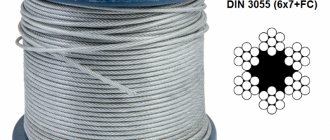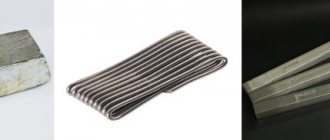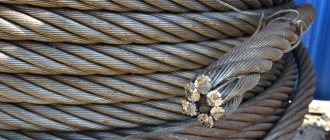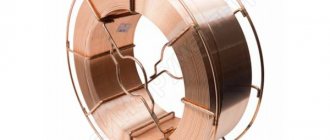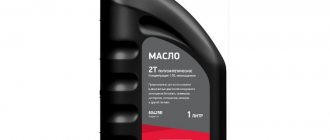Steel rope is one of the most common types of wire products, which are made by various laying methods. Moreover, it is the main element of lifting structures and mechanisms, which carries the entire load-bearing load. Such structures are used in various industries, for example, in mining, coal, oil, mechanical engineering, agricultural and others. And in this regard, there are many types of products made from steel strands and wires. The types will be discussed in more detail in the classification.
The main type of ropes and cables made of steel
There are many classifications of steel ropes depending on the classifying feature. If we take structure as such a feature, then steel ropes can be divided into single, double and triple .
- Single ropes are ropes twisted from one or several layers in a spiral. Or else they are called spiral ropes, the name of which comes from the laying method. Single ropes are intended for laying cables. The cables are made from single strands of round cross-section.
- Double - made by concentrically laying strands in 1 or several layers. They are designed to make stronger ropes, also called strands.
- Triple lay ropes are made from strands using the method of single-layer concentric lay in a spiral.
In addition to structure, there are other main classifying features. For example, cross-sectional shape, weaving type, core material, laying method and direction, mechanical properties, manufacturing accuracy and purpose. Steel cables can have either a flat or a round cross-section. The steel strands from which the cables are woven are also divided according to the cross-sectional shape into round and shaped strands, and the latter, in turn, are flat-stranded and three-stranded.
Based on the type of weaving , ropes are classified as:
- products made of wires in which the layers are touched using a point method, this type of weaving is called point touching (TC);
- products consisting of layers of wires touching each other in a linear manner; this type of weaving is called linear touching and is designated as LC;
- in such products wires of the same diameter are used, they are conventionally designated as LK-O;
- a type of weaving in which the wires in the last layer have different diameters, symbol LK-R, indicating a linear tangency;
- LK-Z, a type of weaving in which the wires touch linearly and with each other and with the filling wires;
- LK-RO - as can be seen from the abbreviations, such wires include strands braided linearly, having different diameters.
- TLCs are a combination of the first two types. That is, the wires come into contact using the linear-point method.
Based on the material of the core, they are distinguished - with an organic core, that is, in the center of the strands it is made of synthetic or natural fibers such as manila, hemp, cotton, nylon, lavsan, viscose, etc.
According to the weaving method , there are unwinding and non-unwinding ones, which differ from each other in that the latter retain the original position of the strands after use. Weaving can be either to the right or to the left. To determine the direction you need to look at the last layer, depending on the structure it can consist of wires or strands, for example, in a single lay the outer layer consists of wires, and in a double lay it consists of strands, and in a triple lay it consists of strands.
According to their mechanical properties, ropes are divided into three types based on the quality of the product, respectively, normal, high, and increased quality. All three types have their own symbols: mark1, mark VK and mark V.
There is a classification based on one more important feature - manufacturing accuracy . In terms of accuracy, ropes come in normal accuracy and, accordingly, increased accuracy, which is designated as T. Increased accuracy differs from normal accuracy in the presence of a maximum deviation in the diameter of the rope.
Design
Metal ropes may have a different design from each other, but the basis for all products is the same. The core of the rope is based on a core, and the wire is woven around it. The core is made not only of steel, but also of non-metallic materials. A steel core is necessary to model the future rope and to protect its surface from sagging. Most often it is protected with an anti-corrosion coating made of zinc, less often polymers are used for these purposes.
If a core made of organic materials is used, it could be, for example, hemp or sisal, then it is impregnated with a special lubricant. This avoids its premature rotting and reduces friction between its components. Cores made of polyamide threads are often used. An important advantage of all ropes with inorganic cores is their low weight and high flexibility.
- In general, according to the level of flexibility, the following types of steel ropes are distinguished:
- With a low degree. This level corresponds to a product with 42 wires and a hemp core.
- With an average degree. This type corresponds to a rope with 72 wires twisted into strands.
- With a high degree. This level includes a cable with a hemp core and steel wire in the amount of 144 pieces, twisted into 6 strands.
Before choosing a cable, it is necessary to take into account a number of its properties. The main characteristic of steel ropes, which we have already mentioned, is flexibility. It largely determines in what area the rope will be used. It is also necessary to take into account strength, maximum tension, and load capacity. The tensile strength depends on the safety factor and the diameter of the cable. Often an important parameter is resistance to aggressive environments; with increased requirements, the product undergoes additional processing. Sometimes it is important to consider the weight of the rope.
Purpose of steel ropes
As mentioned above, steel cables are the main load-bearing elements of any lifting mechanism. For example, a crane, drilling rig, excavators, freight and passenger elevators and others. In addition, steel cables are used as a material for the manufacture of load-handling and other durable devices that can withstand enormous mechanical loads. Therefore, it is important to approach the selection of such products with great responsibility. Today, the market offers a wide range of cables and ropes made of steel, and in connection with this, the buyer is faced with the problem of choice.
In order not to make a mistake with your choice, you need to understand all the features and nuances, which can take years to study. Therefore, experts recommend turning to professionals when purchasing steel products. But nevertheless, there are criteria that professionals adhere to, and the average buyer should adhere to them.
Steel cable structures
The cable structure includes the following components: core, strand, wire, central wire. Most often, each individual wire is arranged around a central wire, forming a strand of wire.
Strands are formed around a central core to form a cable. Depending on the number of strands, the thickness of the cables is determined. There are quite a lot of them, but there is a limit on the number of threads - 25. The size and number of wires in each strand, as well as the size and number of strands in the rope, greatly influence the characteristics of the rope.
Mostly a large number of wires and small strands form flexible cables that have good bending resistance. Such options are suitable for organizing trigger mechanisms.
Fewer, thicker wires and strands result in a less flexible rope with good corrosion resistance and durability. This option is suitable for use in static conditions. Rope design is also important for assessing ropes for corrosion resistance and wear levels.
Types of cores in steel cables
Cables come with three types of cores:
- A wire core that has the same construction as the outer cores.
- Fiber core is more often used for rigging. Such cables have high tensile strength, and due to the increased wire diameter, they are more resistant to abrasion. For the manufacture of such cables, sisal (coarse fiber) or polypropylene is most often used. This makes it possible to provide a flexible base for the strands in the rope structure. Fiber cores are used to make ropes where elasticity is required. Fiber cores are not suitable for outdoor use.
- Independent steel cable core. This type is suitable for the manufacture of cables that are used in tension, subject to severe compressive loads, and high operating temperatures. This type of rope is heavier and stronger than fiber-core rope.
Application area
One of the most notable types of steel cables produced by modern industry is a product made of galvanized wire. For additional protection against corrosion, this steel cable is encased in a PVC sheath. Thanks to these features of its design, the cable can be successfully operated even in the most unfavorable conditions. Thus, products of a similar design are used for tying loads lowered into liquid media; they are used to install antennas and masts, power transmission and communication lines.
Modern manufacturers have also mastered the production of metal-polymer cables, the wire of which can be additionally galvanized, which gives the product even greater corrosion resistance. There is a simpler way to protect the cable from the occurrence and development of corrosion processes, which is also used by modern manufacturers. To do this, a flexible steel cable is coated with a layer of special lubricants or an additional layer formed from galvanized wire is introduced into its structure.
On the modern market you can also purchase cables whose surface is protected by a material that can successfully withstand combustion, high temperatures and temperature changes.
Deformation and wear of ropes
Most often, wire connections fail due to tension, corrosion or mechanical stress. When ruptures are detected under loads, it is important to check the level of safety, especially if the rope is used for heavy loads.
Corrosion damage occurs as a result of operation in wet, salty, acidic conditions or exposure to other chemical elements. In this case, you need to make every effort to fix the problem. Alternatively, you can use a special lubricant.
Mechanical damage consists of cuts or punctures. This occurs due to careless handling, impact. Mechanical rupture also occurs due to sudden release of heavy weight.
Deterioration of the strength of cable strands often occurs as a result of bending wear. The reasons for abrasion of strands may be:
- bending and twisting of ropes due to load;
- contact stresses between individual strands;
- wind fluctuations and other dynamic effects. The source of the oscillation is called a "reclaimer".
When choosing a cable for specific purposes, it is important to pay attention to the quality of the material and its properties. If you intend to use the rope in harsh environmental conditions, be sure to lubricate the product. Steel cables are a complex engineering object, the selection of which must be approached wisely.
Lay in steel cables
The lay in metal cables determines how the wires in the strands form the structure of the rope. In simple words, the wire strands have a twisting algorithm that provides a tightly formed structure. The term “lay” is used to describe the direction of the twisted wire in relation to the strands in the finished cable. With correct laying, the strands are wound around the rope core clockwise, with left-handed or right-handed - counterclockwise.
Conventional lay means that the wire in the strand is laid in the opposite direction to the direction in which the strands are laid in the final rope. The direction of lay of a cable rope does not affect the breaking force of the cable. However, the combination of strand lay and rope lay greatly influences the performance of the cable. For example, if we are talking about a rope structure where rotation is prevented when right-handed and left-handed strands are involved.
Recommendations for the use of various rope designs
Each rope design has advantages and disadvantages that must be properly taken into account when selecting ropes for specific operating conditions. When choosing, you should maintain the necessary relationships between the diameters of the winding elements and the diameters of the ropes and their outer wires, as well as the necessary safety margin to ensure trouble-free operation.
Single lay ropes made of round wires - ordinary spiral ones (GOST 3062-80; 3063-80; 3064-80) have increased rigidity, so they are recommended for use where tensile loads on the rope predominate (lightning protection cables of high-voltage power lines, fences, guy wires and etc.)
Double lay ropes with linear touching of the wires in the strands, while being easy to manufacture, have relatively high performance and have a sufficient number of different designs. The latter allows you to select ropes for work under large end loads, with significant abrasive wear, in various aggressive environments, with the minimum permissible ratios of the diameter of the winding element and rope diameter.
Ropes of the LK-R type (GOST 2688-80, 14954-80) should be used when, during operation, the ropes are exposed to aggressive environments, intense alternating bending and work in the open air. The great structural strength of these ropes allows them to be used in many very stressful operating conditions of crane mechanisms.
LK-O type ropes (GOST 3077-80, 3081-80; 3066-80; 3069-80; 3083-80) work stably under conditions of severe abrasion due to the presence of increased diameter wires in the upper layer. These ropes are widely used, but their normal operation requires a slightly increased diameter of blocks and drums.
Ropes of type LK-Z (GOST 7665-80, 7667-80) are used when flexibility is required, provided that the rope is not exposed to an aggressive environment. It is not recommended to use these ropes in aggressive environments due to the thin filling wires in the strands, which are easily corroded.
Ropes of the LK-RO type (GOST 7668-80, 7669-80, 16853-80) are distinguished by a relatively large number of wires in the strands and therefore have increased flexibility. The presence of relatively thick wires in the outer layer of these ropes allows them to be successfully used in conditions of abrasive wear and aggressive environments. Due to this combination of properties, the LK-RO type construction rope is universal.
Double lay ropes with point-linear contact of wires in strands of type TLK - O (GOST 3079-80) should be used when the use of ropes with linear contact of wires in strands is impossible due to violation of the minimum permissible adjustment ratios between the diameters of the winding organs and the diameters of the wires of the rope or if it is impossible to ensure the recommended safety factor.
Double lay ropes with point contact of wires in TK type strands (GOST 3067-88; 3068-88; 3070-88; 3071-88) are not recommended for critical and intensively operating installations. These ropes can only be used for non-stressful operating conditions, where alternating bends and pulsating loads are insignificant or absent (slings, bracing ropes, temporary timber fastenings, support and brake ropes, etc.)
Multi-strand double lay ropes (GOST 3088-80; 7681-80) , depending on the accepted directions of laying of the strands in individual layers, are made ordinary and non-twisting. The latter ensure reliable and stable operation on mechanisms with free suspension of the load, and the large supporting surface and lower specific pressures on the external wires make it possible to achieve a relatively high performance of the rope. The disadvantages of multi-strand ropes are the complexity of manufacturing (especially pre-deformation), the tendency to delamination, and the difficulty of monitoring the condition of the internal layers of the strands.
Triple lay ropes (GOST 3089-80) are used when the main operational requirements are maximum flexibility and elasticity of the rope, and its strength and supporting surface are not of decisive importance. Organic cores in strands are appropriate when the rope is intended for towing and mooring, where increased elastic properties of the rope are required. Due to the use of wires of small diameters compared to the wires of double lay ropes, triple lay ropes require pulleys of significantly smaller diameters for normal operation.
Triangular strand ropes (GOST 3085-80) are characterized by increased structural stability, a very high fill factor and a large supporting surface. The use of these ropes is especially suitable for high end loads and severe abrasive wear. It is recommended to use these ropes both in installations with friction pulleys and in multi-layer winding on drums. The disadvantages of triangular strand ropes are sharp bends of the wires on the edges of the strands, increased rigidity of the rope, and the complexity of manufacturing the strands.
Flat ropes (GOST 3091-80; 3092-80) are used as balancing ropes in mine hoisting installations. The advantages of these ropes include their non-twisting properties. However, the manual operations involved in sewing ropes and the relatively rapid destruction of the collar during operation limit the extent to which these ropes can be used in industry.
